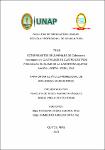Ectoparásitos de juveniles de Colossoma macropomum, cultivados en cuatro centros piscícolas en el eje de la carretera Iquitos - Nauta Loreto - Perú, 2018

View/
Date
2021Author
Murrieta Vásquez, Pamelita de Jesús
Reyes Roman, Jorge Pablo
Metadata
Show full item recordAbstract
El objetivo del presente estudio fue identificar los ectoparásitos de juveniles de Colossoma macropomum, que se cultivan en cuatro centros piscícolas (CP1, CP2, CP3 y CP4), del eje de la carretera Iquitos-Nauta. Para ello durante los meses marzo a mayo del 2019 se colectaron un total de 84 juveniles de Colossoma macropomum, siendo trasladados a las instalaciones de la ONG´s Amazon Research Center for Ornamental Fishes. Los peces fueron sacrificados y se analizaron muestras de piel, ojos, aletas, narinas, cavidad bucal y branquias. Así mismo, se registraron la calidad del agua de los estanques de cultivo al momento de la colecta de los peces. Los parásitos fueron identificados mediante claves taxonómicas específicas para cada clase de parásito y se determinaron los índices parasitarios, prevalencia, abundancia, intensidad media y abundancia media. Para la relación entre el peso y longitud de los peces, parámetros físicos-químicos (temperatura, pH, oxígeno disuelto, dióxido de carbono y amonio) del agua con la abundancia de los ectoparásitos se utilizó el coeficiente de correlación de Spearman (rs). Se identificaron a tres monogeneos, dos a nivel de especie (Anacanthorus spathulatus y Notozothecium janauchensis) y uno a nivel de género (Mymarotecium sp.), localizados en branquias; asimismo, se identificó a un protozoario, Piscinoodinium pillulare, localizado en piel, aletas y branquias. Los monogeneos estuvieron presentes en los cuatro centros piscícolas, a excepción del protozoario, que estuvo presente en el CP4. Los índices parasitarios fueron diferentes en cada centro piscícola. No hubo relación del peso y longitud de los peces con la abundancia de ectoparásitos. No hubo relación de los parámetros físicos-químicos del agua con la abundancia de los ectoparásitos en los centros piscícolas CP1, CP2 y CP3, a excepción del CP4. Los ectoparásitos monogeneos son frecuentes en el cultivo de los juveniles de Colossoma macropomum. The objective of this study was to identify the ectoparasites of Colossoma macropomum juveniles, which are cultivated in four fish farming centers (CP1, CP2, CP3 and CP4), on the axis of the Iquitos-Nauta highway. For this, during the months of March to May 2019, a total of 84 juveniles of Colossoma macropomum were collected, being transferred to the facilities of the NGO's Amazon Research Center for Ornamental Fishes. The fish were sacrificed and samples of skin, eyes, fins, nostrils, oral cavity and gills were analyzed. Likewise, the water quality of the culture ponds was recorded at the time of the fish collection. The parasites were identified using specific taxonomic keys for each class of parasite and the parasitic indices, prevalence, abundance, mean intensity and mean abundance were determined. For the relationship between the weight and length of the fish, the physical-chemical parameters (temperature, pH, dissolved oxygen, carbon dioxide and ammonium) of the water with the abundance of the ectoparasites, the Spearman correlation coefficient (rs) was used. Three monogeneans were identified, two at the species level (Anacanthorus spathulatus and Notozothecium janauchensis) and one at the genus level (Mymarotecium sp.), Located in gills; Likewise, a protozoan, Piscinoodinium pillulare, located on the skin, fins and gills, was identified. Monogeneans were present in the four fish farming centers, with the exception of the protozoan, which was present in CP4. The parasitic indices were different in each fish farm. There was no relationship between the weight and length of the fish with the abundance of ectoparasites. There was no relationship of the physical-chemical parameters of the water with the abundance of the ectoparasites in the fish farms CP1, CP2 and CP3, with the exception of CP4. Monogeneous ectoparasites are frequent in the culture of Colossoma macropomum juveniles.
Collections
- Tesis [145]

